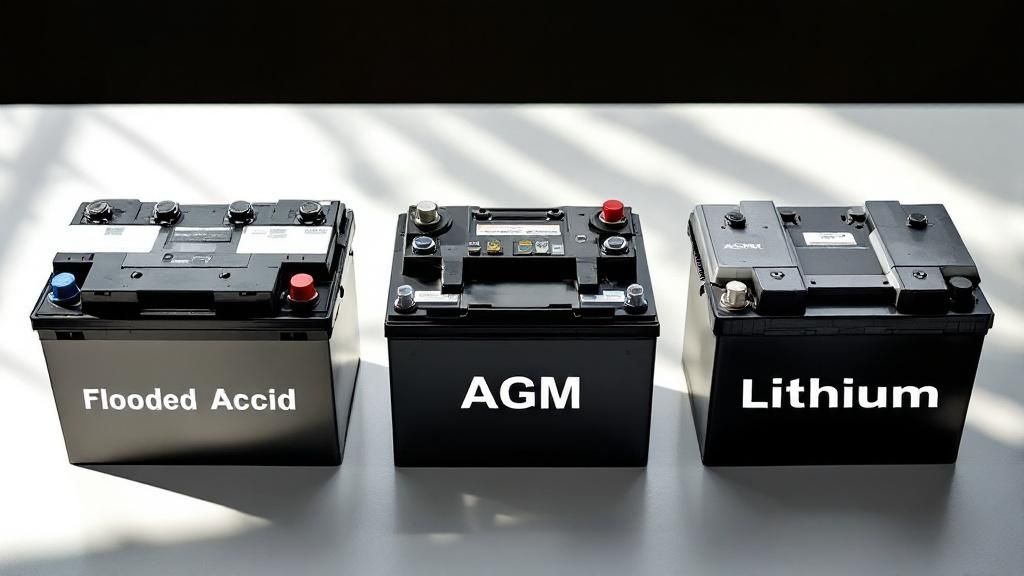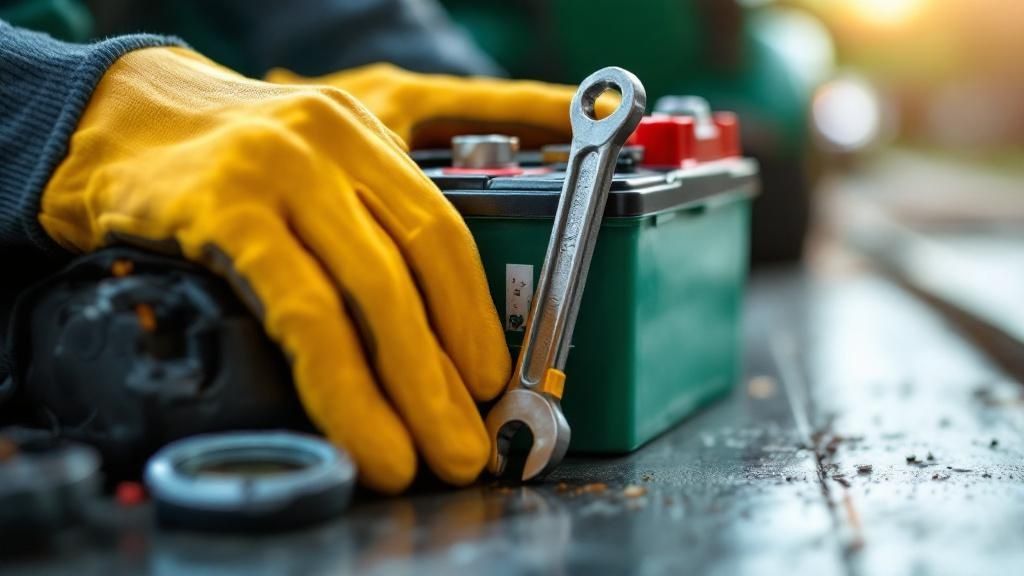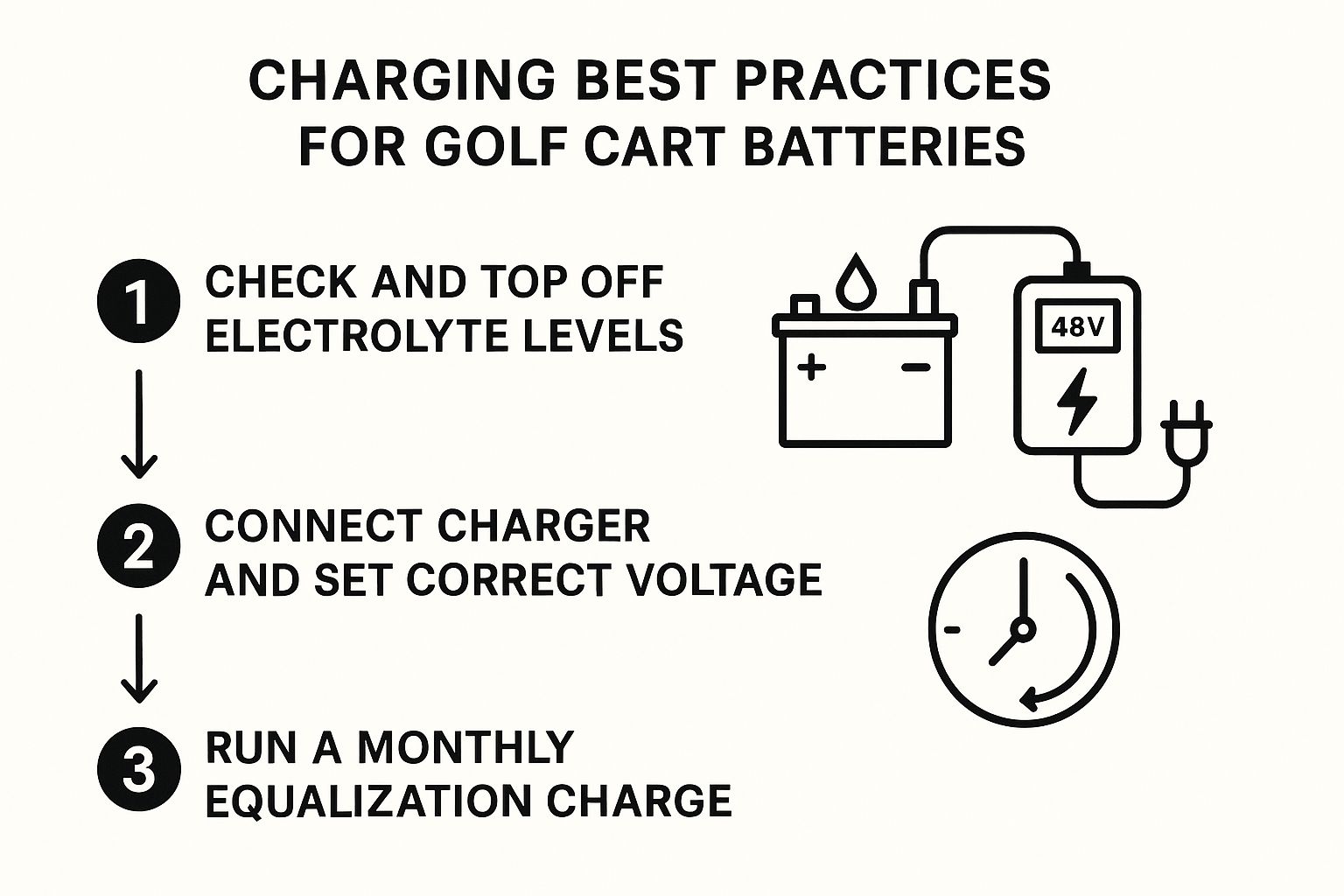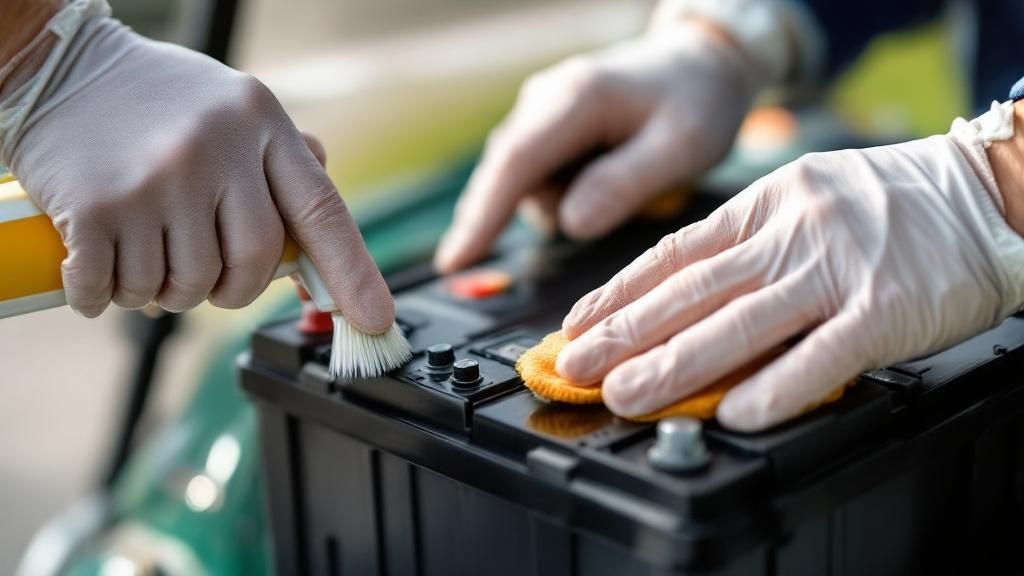When it comes to keeping your golf cart running smoothly, nothing is more important than consistent battery maintenance. A simple routine of inspecting, cleaning, charging, and—for traditional lead-acid types—watering is the secret. This isn't just about avoiding breakdowns; it's about saving real money and making sure your cart is always ready when you are.
Why You Can't Afford to Ignore Your Batteries

We’ve all seen it happen. It’s a beautiful day, you’re cruising toward the back nine, and suddenly… nothing. The cart just dies. It’s a frustrating moment that, frankly, is almost always preventable. A little proactive care for your batteries is the single best way to get the most out of your golf cart.
This guide isn't about generic tips you've heard a dozen times. We're going to walk through the practical, field-tested steps that I've seen make a huge difference. A simple, repeatable routine for either your lead-acid or lithium-ion batteries can dramatically extend their life.
The Real Cost of Neglect
Ignoring your batteries does more than just risk getting stranded; it directly costs you money. For any golf cart owner or fleet manager, the battery replacement cycle is a major budget item. Your standard lead-acid batteries will generally give you 3-5 years of service if you treat them right. The newer lithium-ion batteries, on the other hand, can push that to 8-10 years, effectively doubling the time between replacements.
This is big business. In North America alone, the market for replacement batteries is expected to top $91 million by 2032. You can dig deeper into these numbers and what they mean for golf cart battery economics if you're curious.
I always tell people to think of battery maintenance as an insurance policy. A few minutes each month protects a significant investment and saves you hundreds, or even thousands, in premature replacement costs.
A Playbook for Peak Performance
A disciplined approach to battery care pays for itself over and over. When you follow a structured schedule, you know your cart will be ready to go every single time. The payoff is crystal clear:
- Maximized Lifespan: With proper care, you can easily get years more out of your batteries than the average owner.
- Consistent Performance: A healthy battery pack means reliable power and range, so you're not left guessing if you'll make it back to the clubhouse.
- Increased Safety: Regular checks help you spot corrosion, frayed cables, or other hazards before they turn into real problems.
- Long-Term Savings: It’s simple—you’ll avoid the high cost of buying new batteries too often and dodge expensive repair bills.
Consider this your go-to playbook for getting the best performance and real savings from your golf cart.
Your Essential Battery Care Toolkit

Before you even think about touching a battery, let's talk about getting your gear in order. Showing up prepared is half the battle, and when it comes to golf cart battery maintenance, having the right tools isn't just about making the job easier—it's about doing it safely and correctly.
This isn't a job for a generic toolbox. We're dealing with specific needs, especially for traditional lead-acid batteries. A few key items are absolutely essential for understanding what's going on inside those cells and preventing costly, irreversible damage.
Don't Skip the Safety Gear
Let's be clear: working with lead-acid batteries carries real risks. You’re dealing with corrosive sulfuric acid and enough electrical power to create a dangerous spark. People get complacent, and that's when accidents happen. A splash of battery acid can cause nasty burns, and shorting a terminal can do more than just startle you.
This is why safety gear is non-negotiable.
- Insulated Gloves: These are your first line of defense, protecting your hands from acid and preventing you from accidentally creating a circuit if you touch two terminals at once.
- Safety Glasses or Goggles: Your eyes are irreplaceable. One tiny droplet of acid can cause permanent vision damage. Full-coverage eye protection is a must, not a suggestion.
These safety fundamentals are crucial, whether you're servicing a golf cart or learning the basics of general electric vehicle maintenance. The principles always apply.
A quick story: I saw a guy lean over a battery years ago without any glasses on. A little acid bubbled up and sprayed his cheek—he was lucky it missed his eye. That's a mistake you only make once. Don't learn that lesson the hard way.
The Right Tools for the Job
Alright, with safety covered, let's assemble the toolkit that will make your maintenance routine smooth and effective. Having these specific items on hand turns a potentially messy chore into a quick, professional job.
To make it simple, here’s a quick-glance table of everything you’ll need to do the job right from the start.
Essential Maintenance Tools and Safety Gear
| Item | Purpose | Why It's Critical |
|---|---|---|
| Battery Hydrometer | Measures the specific gravity (density) of the electrolyte in each cell. | This is the only way to get a true health report on a lead-acid battery. A voltage meter alone can be deceptive. |
| Terminal Brush | A wire brush made specifically for cleaning battery posts and cable clamps. | Corrosion is the enemy. It creates resistance, which hinders charging and chokes off power. Clean connections are everything. |
| Distilled Water | For topping off fluid levels in serviceable lead-acid batteries. | Tap water is full of minerals that will build up on the battery's lead plates, permanently killing its capacity. Only use distilled water. |
| Baking Soda | A safe and cheap way to neutralize acid spills and clean corrosion. | A simple paste of baking soda and water instantly neutralizes corrosive acid, protecting the battery case and your cart's frame. |
Gathering these items before you start will save you from running to the store mid-job and ensures you can handle whatever you find when you pop open the battery compartment.
A Proactive Battery Inspection Routine You Can Actually Stick To
Think of this as a quick monthly health checkup for your golf cart's batteries. A consistent inspection routine is your best defense against the most common—and most expensive—battery problems. It’s what separates the pros from the amateurs and helps you catch the small stuff before it turns into a catastrophic failure that leaves you stranded.
This isn't about being a master mechanic. It's about being a smart owner. With just a few minutes each month, you can move from reacting to dead batteries to proactively keeping them in peak condition for years.
Look for Physical Damage
First things first, just use your eyes. Take a good, hard look at the entire battery bank. You're searching for any outward signs that something is wrong on the inside.
Check the plastic battery cases for any bulging or swelling. If a battery looks bloated, it's a classic sign of overheating or overcharging. Also, run your eyes (and even your hands) over the tops and sides, looking for hairline cracks or leaks, paying extra attention to the areas around the terminals. Finding a small crack early can save you from a full battery replacement down the road.
Make Sure Cable Connections Are Rock Solid
Now, let's look at the cables—the arteries of your electrical system. Loose connections are a notorious source of poor performance and can even become a serious fire hazard.
Grab each cable right where it connects to the terminal and give it a firm wiggle. You should feel zero movement. If anything feels loose, grab the right size wrench and snug up the nut. Don't go crazy and overtighten it; you could strip or break the soft lead post. A snug, secure connection is all you need for maximum power and efficient charging.
A loose connection creates electrical resistance, which generates a ton of heat. That heat can melt terminals, slash your battery efficiency by up to 15%, and permanently ruin both your batteries and cables. It’s a silent performance killer.
This simple check is also a great time to ensure your cart is ready for public roads. For more information on modifications, check out our guide detailing how to make your golf cart street legal.
Clean Up Terminals and Cables
While you're checking the connections, you’ll probably see any corrosion that's built up. It's usually a crusty, fuzzy-looking deposit that's white or greenish-blue, and it loves to grow on battery terminals.
You absolutely have to get that stuff off. The best trick in the book is a simple paste made from baking soda and a little water. Slather it on the corroded spots and let it do its thing—it'll bubble and fizz for a minute. Then, just scrub it all away with a wire brush (a dedicated terminal brush works best) and rinse the area with clean water. Make sure everything is completely dry when you're done.
Check and Top Off Water Levels (For Lead-Acid Batteries)
If you have traditional "flooded" lead-acid batteries, this last step is absolutely critical. Your batteries need the right amount of water to work correctly.
Important: Only do this after the batteries have been fully charged. Carefully pop the vent caps off each cell and peek inside. The water (electrolyte) level should be just high enough to cover the metal plates inside—usually about a quarter-inch above them is perfect. If a cell is low, top it off using distilled water only. Never, ever use tap water; the minerals in it will poison your battery from the inside out.
The image below shows where this fits into the overall process—you always check the water after a full charge.

As you can see, topping off the fluid is a key part of the post-charging routine, ensuring the battery is perfectly prepped for its next use.
Mastering Your Charging Strategy

Plugging in your golf cart seems pretty straightforward, right? But believe me, a smart charging strategy is one of the biggest factors in golf cart battery maintenance. The way you charge directly impacts how long your batteries will last. Get it right, and you can add years to their life. Get it wrong, and you might be replacing them in half the time.
The golden rule for traditional lead-acid batteries is simple: recharge them after every single use. I don't care if you just drove it down to the mailbox and back. Plug it in. This isn't just a fussy recommendation; it's your primary defense against a nasty chemical process called sulfation.
When a lead-acid battery sits around partially discharged, lead sulfate crystals start to form and harden on the battery plates. If they sit too long, they become permanent, and you can't dissolve them through charging. This robs your battery of its capacity for good. Think of it like plaque building up in an artery—the longer it’s there, the more permanent the damage.
The Pitfalls of Poor Charging Habits
One of the most common mistakes I see people make is "opportunity charging"—plugging the cart in for just an hour here or there. This is especially damaging for lead-acid batteries because they never get to complete a full charge cycle, which just speeds up sulfation.
On the other end of the spectrum, overcharging is just as bad. If you're using an old manual charger and forget about it, you can literally boil the electrolyte fluid away, exposing the lead plates and causing catastrophic failure. This is why a modern "smart" charger is non-negotiable. It knows when to stop and will automatically switch to a maintenance or "float" mode once the batteries are full.
A disciplined charging routine is your best weapon against premature battery failure. Always aim for a complete, uninterrupted charge cycle after every single use to keep the internal chemistry of your batteries healthy. This simple habit protects your investment better than anything else.
The Lithium-Ion Charging Advantage
Now, if you have lithium-ion batteries, you can forget almost everything I just said. They completely change the game. Lithium batteries aren't susceptible to sulfation, so the charging rules are way more relaxed. You absolutely do not need to top them off after every short trip. In fact, lithium batteries are happiest when they aren't kept at a 100% charge all the time.
This flexibility is a huge reason they've become so popular. In fact, lithium-ion batteries now make up about 43.3% of the global golf cart battery market, a number that's growing fast. Their impressive lifespan and faster charging times—often just 2-4 hours compared to 6-8 hours for lead-acid—are hard to ignore. You can read more about this market shift on Allied Market Research.
Here’s a quick breakdown of how the two types compare when it comes to charging.
Charging Best Practices
| Feature | Lead-Acid Batteries | Lithium-Ion Batteries |
|---|---|---|
| Charge Frequency | After every use, without fail. | Flexible; no need to charge after every short trip. |
| Partial Charging | Very harmful; causes sulfation. | Perfectly fine; does not damage the battery. |
| Full Charge | Essential to complete a full cycle every time. | Not necessary; can be stored at partial charge. |
| Charge Time | Typically 6-8 hours. | Typically 2-4 hours. |
At the end of the day, you need to know what you’ve got under the seat. If it's lead-acid, be disciplined and consistent with your charging. If it's lithium, enjoy the freedom and convenience. Tailoring your routine to the technology is key.
Seasonal Storage and Off-Season Care
How you put your golf cart away for the winter can literally make or break your batteries. I've seen it countless times: a cart gets parked in the fall and come springtime, the owner is looking at a bill for a whole new battery pack. Proper off-season care isn't just a suggestion; it’s one of the most important parts of a solid golf cart battery maintenance routine.
Simply leaving your cart to sit unattended for months is a surefire way to kill your batteries. Lead-acid batteries naturally lose their charge over time—a process called self-discharge. If that charge level drops too far, sulfate crystals build up and harden on the battery plates, and once that happens, they're often damaged for good. You can’t just park it and forget it. You need a game plan.
Preparing for Hibernation
Your first move, before anything else, is to give the battery pack a 100% full charge. Think of this as giving your batteries the biggest head start possible against the slow drain of self-discharge. Starting with a full tank gives them the longest runway before they dip into the danger zone. Storing a cart with a half-dead battery is asking for trouble.
Next, you need to find the "Tow/Run" switch. It's usually a big red or black switch under the seat, right near the batteries. Flip it into the "Tow" position. This is a crucial step because it acts like a master disconnect, cutting off the battery pack from the controller and other electronics that create a slow, parasitic drain, even when the key is off.
Forgetting to flip the "Tow" switch is like leaving a small light on in a closet for three months. It’s a slow, silent killer for your battery pack, draining it bit by bit until there’s nothing left.
Keeping the Charge Up During Storage
Even in "Tow" mode, your batteries will still self-discharge. The absolute best way to handle this is with a quality automatic battery charger or a smaller device called a battery tender. These smart chargers watch the battery's voltage and only send a small trickle of power when needed to keep the pack topped off. It’s the perfect solution to prevent both undercharging and the damage that can come from overcharging.
Where you store the cart matters, too. You're looking for a cool, dry place. Bitter cold can sap a battery's efficiency, while high heat actually makes them self-discharge faster and can shorten their overall lifespan. If you have a climate-controlled garage, that's the ideal spot.
The off-season is also the perfect time to handle any administrative tasks, especially if you drive your cart on public roads. It's a good idea to brush up on local rules and regulations. If you need some pointers, you can learn more from our guide on how to make a golf cart street legal.
Stick to this simple process, and when the sun comes out again, your cart will wake up with healthy batteries, ready to roll for another season.
What's Next? A Look at Automated Battery Maintenance
Let's be honest, nobody loves the tedious, hands-on part of battery care. The good news is that those days of constant manual checks are on their way out. The future of golf cart battery maintenance is shifting away from being a chore and toward a smart, automated process.
At the center of this evolution is the Battery Management System (BMS). Think of it as the onboard computer for modern lithium-ion batteries. This little piece of tech is a game-changer, acting as a constant guardian for your battery's health. It’s always working in the background to prevent the most common killers of batteries, like overcharging, draining them too low, or operating in dangerously hot or cold conditions. Some systems even send real-time alerts and performance data straight to your smartphone.
Smarter Systems are Already Here
This isn't just some far-off concept; it’s already making a real difference. Large operations like golf courses and big resorts are finding that a smart BMS can slash the time spent on manual maintenance checks by 30-50%. On top of that, they're seeing better battery performance and a longer lifespan. This move toward data-driven care is a major shift, and you can see more about these trends in global golf cart battery forecasts.
A BMS fundamentally changes battery care from a reactive headache to a proactive strategy. Instead of just waiting for something to go wrong, the system works 24/7 to stop problems before they start. That means more reliability and a battery that lasts as long as it should.
Looking down the road, this automation is only going to get more sophisticated. We're seeing exciting developments in connected technology, and I believe the role of IoT in enhancing electrical efficiency will play a massive part in what comes next. It all points to a future where owning and maintaining a golf cart becomes practically effortless.
Your Top Battery Maintenance Questions Answered
Even the most thorough guide can leave you with a few lingering questions. After working with countless golf cart owners over the years, I've noticed the same handful of queries pop up time and again. Let's tackle them head-on.
The Great Watering Debate: When and How?
One of the most common points of confusion is about watering those traditional lead-acid batteries. The timing is everything here. You'll want to pop the caps and check the water levels every 2 to 4 weeks.
Here’s the critical part: only add water after the batteries have finished a full charge. If you top them off beforehand, the liquid can expand during charging and bubble over, creating a dangerous and corrosive mess on your battery tops and frame.
My Golden Rule: Always, and I mean always, use distilled water. Tap water is loaded with minerals that will cake onto the internal lead plates. This buildup, known as scaling, is a one-way ticket to a dead battery, as it permanently cripples its ability to hold a charge.
Smart Chargers, Dumb Mistakes, and Lithium Upgrades
Next up is charging. "Can I just leave my cart plugged in all the time?" I hear this one a lot. The answer is a solid "maybe." It all comes down to your charger.
If you have a modern, automatic "smart" charger, then yes, you can leave it connected. These chargers are designed to shut off or switch to a maintenance "float" mode once the batteries are full. But if you're using an older, manual charger, leaving it plugged in is a recipe for disaster. It will keep pumping power, overcharge your batteries, and cook them into oblivion.
This naturally leads us to the million-dollar question: "Should I just upgrade to lithium-ion batteries?"
For the vast majority of cart owners who want less hassle and more performance, my answer is a firm yes. The upfront cost is higher, there's no denying it, but the long-term advantages are impossible to ignore.
- Longevity: Lithium batteries typically last a solid 8-10 years. Compare that to the 3-5 years you'll get from lead-acid, and the math starts to make sense.
- Zero Maintenance: Seriously. No more watering, no more cleaning corrosion. Just plug it in and go.
- Charging Freedom: They charge much faster and don't mind being partially charged. You don't have to follow a rigid charging schedule.
- Lighter Load: Lithium batteries are significantly lighter, which can give your cart a little extra zip and improve its overall efficiency.
If a maintenance-free experience and better performance over the long haul sound good to you, a lithium upgrade is one of the smartest investments you can make for your cart.
Ready to experience the future of electric mobility? The Solana EV lineup offers cutting-edge design, robust performance, and street-legal convenience without the constant upkeep. Explore our models and find your perfect ride.
